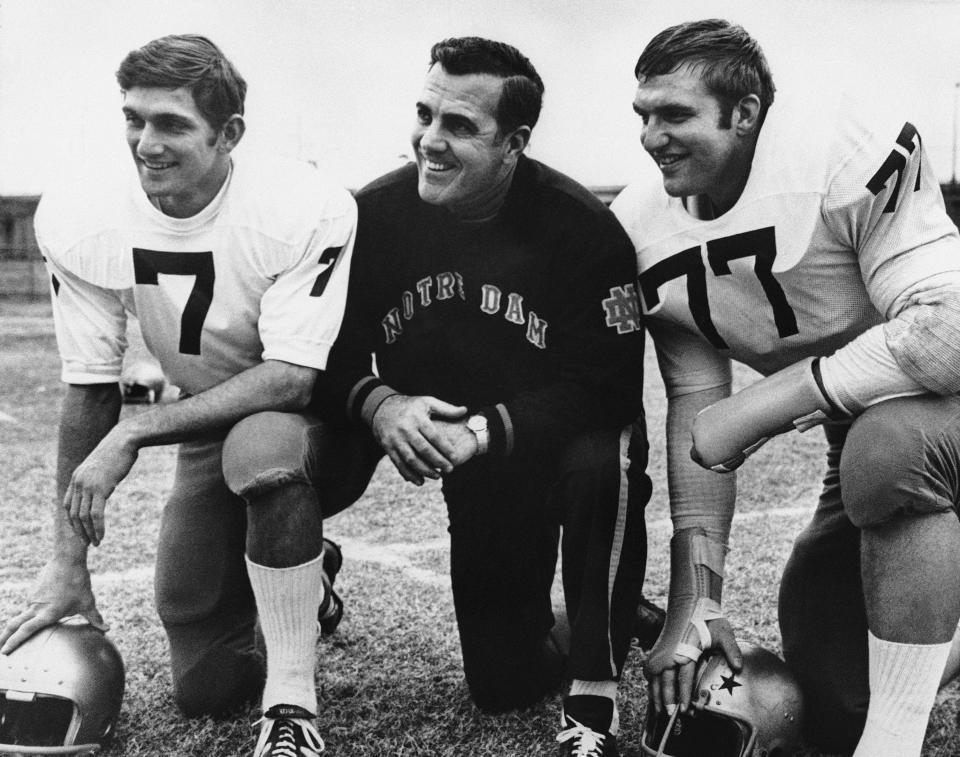Ara Parseghian was a man ahead of his time
In an era of authoritarian college football coaches – distant, growling monarchs named Woody and Bear and Bo – the man in charge at Notre Dame told his players this:
“Don’t call me Coach. Call me Ara.”
The Fighting Irish didn’t dare take Ara Parseghian up on that offer – it was too far outside the rigid coach-player interpersonal dynamic of the 1960s and ’70s. But they did embrace a man who chose dialogue over monologue, who welcomed questions, who did not view the dramatically changing times as the end of times.
The anti-autocrat died Wednesday at age 94. Parseghian departs this Earth with two national titles on his professional résumé and hundreds of profound impressions upon players on his personal résumé.
“He was fun to be around, had a great presence, was very approachable,” said Big Ten Network analyst Gerry DiNardo, a former college football coach who played under Parseghian at Notre Dame. “That was unique in that day and era, when most players didn’t approach their coach. He found a way to communicate with us.”
DiNardo said Parseghian communicated about issues important to the players: the Vietnam War; race relations; Notre Dame’s move from all-male enrollment to a coed campus; rules about hair length and sideburn length. He was an extension of the progressive, dynamic leadership of school president Father Theodore Hesburgh. In a time of great societal change, Parseghian didn’t ignore the big issues that rocked campuses nationwide.
“He would bring stuff up,” DiNardo said. “He was a coach who wasn’t afraid to talk about those things.”

Parseghian won over his players in a different way than the fear factor employed by many of his coaching peers. Which might be why he was so beloved, and why the Irish played so hard for him in his final game.
In the span between the end of the 1974 regular season and Notre Dame’s date with undefeated Alabama in the Orange Bowl, word of a decision made weeks earlier leaked out: Parseghian was retiring after the bowl game. It was shocking news – he was just 51 years old, and a year removed from his second national title. It served as motivation for a mammoth upset.
“They were better than us,” DiNardo said. “But we were determined to make his last game a win.”
The Irish were 9-2 and staggered into the Orange Bowl off a 31-point loss to USC. The Crimson Tide rolled in with ample motivation: They were ranked No. 1 by UPI and No. 2 by AP, with a bowl victory assuredly wrapping up at least a share of the national title; and ‘Bama was burning for revenge after a one-point loss to Notre Dame in the Sugar Bowl the year before with the national championship on the line.
The inspired Irish jumped out to a surprising 13-0 lead, then spent the rest of the game holding on for dear life. With the score 13-11, Alabama was driving for what seemed to be the winning score when Reggie Barnett intercepted a pass and sent Parseghian out on the shoulders of his players.
“It was a big, big, big deal,” DiNardo said.
It was the end of a brief but golden era, an 11-year-run that woke up the echoes of America’s most storied football program. Notre Dame hadn’t recorded a winning season in the five years prior to Parseghian’s arrival from Northwestern, and at the time it was fair to wonder whether the program would ever regain its lost luster.
It happened immediately, thanks to Parseghian’s mastery of the totality of coaching.
“He knew both sides of the ball,” DiNardo said. “He didn’t have coordinators. He had a lead coach on either side, but he called the plays and he knew what was going on defensively at all times.”
Parseghian won his first nine games at Notre Dame coach, and it was only a 20-17 loss at USC that cost the Fighting Irish a shot at the 1964 national title. Two years later Notre Dame did win it all, thanks in part to the immortal and controversial 10-10 tie with Michigan State.
Both teams were undefeated and untied entering that game in East Lansing. Parseghian’s decision to conservatively play for a tie was widely criticized but based in logic: his team was No. 1 and on the road against the undefeated No. 2 team in the land, and a tie would not alter that equation. When Notre Dame demolished USC the next week, 51-0 – one of six shutouts the Irish recorded that season – the national title was secured. (In those days the school did not accept bowl bids.)
It was part of an 11-year run in which Notre Dame was never ranked lower than 15th in the final polls, and only twice finished outside of the top 10. National titles were subsequently won by Dan Devine in 1977 and Lou Holtz in ’88, but the consistent excellence from the Era of Ara has never again been duplicated in South Bend.
Parseghian wasn’t lavishly paid at Notre Dame – at the time, he was contractually prevented from making more than the school’s highest-paid faculty member. But he opened an insurance company while still coaching, did some endorsements and became a TV broadcaster. Then he found another great calling later in life, raising money for the Ara Parseghian Medical Research Foundation, a pursuit inspired by the death of three grandchildren from Niemann-Pick C Disease.
“He was way ahead of his time,” DiNardo said.
Today, the Era of Ara stands out as arguably the last true Golden Era at Notre Dame.

